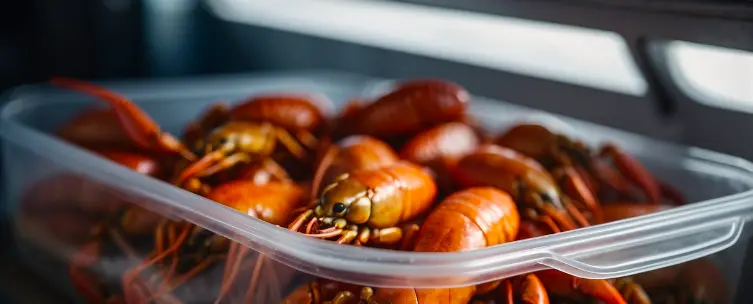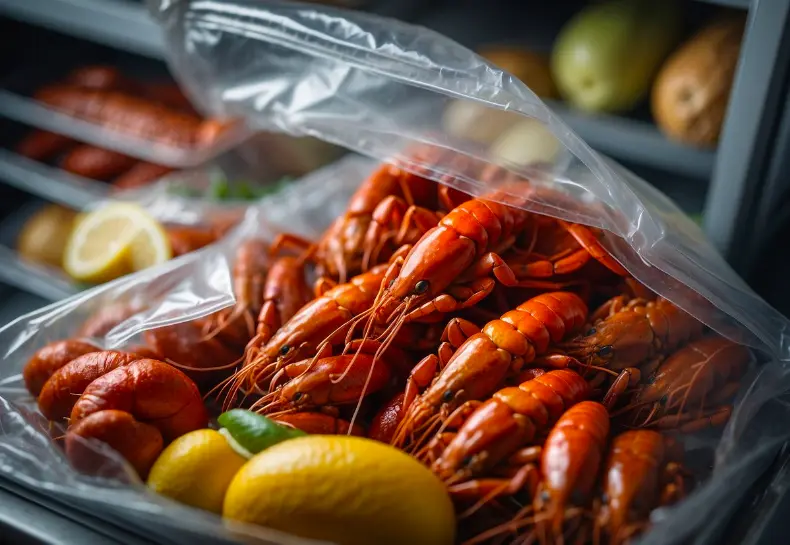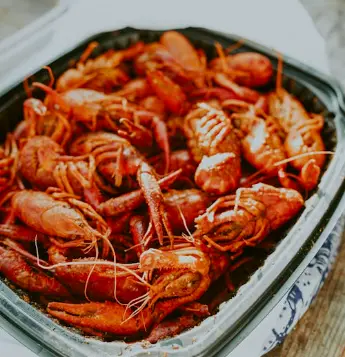In my experience with seafood preservation, crawfish, also known as crayfish or crawdads, are popular for their sweet, succulent meat and are often enjoyed in dishes like etouffee, jambalaya, or simply boiled. If you find yourself with leftovers or an abundance of fresh crawfish, proper storage is essential to maintain their freshness and safety for future consumption. When stored in the refrigerator, boiled crawfish typically remain fresh and safe to eat for 3 to 4 days. It’s important to place them in airtight containers or tightly sealed bags to prevent any cross-contamination and odor absorption from other foods.

Storing fresh, live crawfish before cooking presents a slightly different challenge. They should be kept alive until you’re ready to cook them, ideally in a well-ventilated container and under refrigeration. This method helps to ensure they remain fresh, as deceased crawfish can spoil quickly and affect the quality of your dish. Overall, my understanding reassures me that with the right storage techniques, crawfish can be enjoyed a few days after they’ve been cooked, provided they’re handled and refrigerated promptly after serving.
Understanding Crawfish Storage Basics
When I purchase fresh crawfish, whether planning a lively crawfish boil or simply enjoying the delicacy at home, I recognize the importance of proper storage to ensure food safety and maximum freshness. Live crawfish should be kept alive until cooking, and there are techniques to help prolong their viability.
Storing live crawfish at room temperature is not advisable due to the risk of them perishing quickly, compromising both texture and flavor. To extend their life before cooking, I store my live crawfish in a cool environment, ideally around 36-46°F (2-8°C), which can typically be achieved in a regular fridge. Covering them with a damp cloth helps maintain the necessary humidity.
For storage after a boil or when I have leftover cooked crawfish, an airtight container is essential. The storage duration in the refrigerator, in my experience, should not exceed 2-3 days for optimal quality, as highlighted in guidelines on maximizing crawfish freshness.
I summarize the storage basics as follows:
Live Crawfish:
- Keep cool at 36-46°F (2-8°C)
- Use a damp cloth for humidity
- Avoid room temperature storage
-
- Refrigerate in airtight containers
- Consume within 2-3 days
Properly storing live and cooked fresh crawfish is critical to maintaining their quality and flavor, as well as ensuring these delectable crustaceans are safe to eat.
Refrigeration of Cooked Crawfish

After enjoying a delicious meal of crawfish, storing the leftovers properly is crucial. I will discuss how to refrigerate cooked crawfish effectively and identify when they are no longer safe to consume.
Proper Refrigeration Techniques
To ensure the longevity and safety of cooked crawfish, I always store them in an airtight container. This method prevents contamination and the spread of any odors within the refrigerator. Cooked crawfish should be cooled to room temperature before refrigeration but not left out for more than two hours to avoid bacterial growth. Once cooled, they must be refrigerated promptly. When stored correctly at 40°F (4°C) or below, cooked crawfish can be expected to last for 3-4 days in the refrigerator.
Signs of Spoilage
Crawfish are only as good as their shelf life. Throughout my experience, I’ve learned that it’s critical to recognize clear signs of spoilage to prevent foodborne illnesses. These signs include:
- An unpleasant odor; fresh cooked crawfish should have a mild, sea-like scent.
- Changes in texture, such as mushiness or sliminess on the shell or flesh.
- Any signs of discoloration or mold on the cooked crawfish also indicate that they should not be consumed.
By being wary of these signs and following the above refrigeration techniques, cooked crawfish can be safely enjoyed for a few days after preparation. Remember, when in doubt, it’s wiser to discard any suspect seafood to ensure safety.
Extending Crawfish Shelf Life

I find that proper storage techniques are vital to extending the shelf life of crawfish. By freezing crawfish, you can enjoy them for an extended period beyond their refrigerated lifespan.
Freezing Process
When I decide to freeze crawfish, I ensure they’re fresh and have been properly prepared. For crawfish tails, I rinse them in ice water and sort out any damaged ones. Whole crawfish need a thorough cleaning before freezing. I place them in freezer bags, squeezing out as much air as possible before sealing to prevent freezer burn. It’s best to lay the bags flat in the freezer to allow for even freezing and space efficiency.
Defrosting and Reheating
Thawing crawfish properly is just as important as the freezing process. I defrost them in the fridge, which usually takes several hours or overnight. For faster defrosting, I submerge the sealed bag in cold water, never warm, as this can encourage bacterial growth. When reheating, I make sure to bring them to an internal temperature of 145°F to ensure they’re safe to eat. It’s crucial not to re-freeze previously thawed crawfish, as this can degrade their quality and pose safety risks.
Identifying and Handling Dead Crawfish

When I store crawfish in the fridge, it is essential to identify if any are dead prior to cooking. Dead crawfish, especially those that were dead before the initial cooking, may carry bacteria that could cause foodborne illness. I look for straight tails on crawfish after cooking, which often indicates they were dead before the boiling process. Crawfish naturally curl their tails when cooked alive, so a straight tail might be a sign of a pre-cooked deceased crawfish.
Identifying Dead Crawfish:
- Before cooking: I make sure they are moving. If not, I check if the crawfish is limp or has a foul odor.
- After cooking: I look for straight tails and avoid consuming these.
Handling Steps:
- Separate: I remove any crawfish with straight tails immediately to avoid contamination.
- Discard: I always dispose of suspected dead crawfish safely.
- Cleanse: I thoroughly clean the area where the dead crawfish were stored to prevent bacterial spread.
By following these steps, I confidently minimize risks associated with eating potentially spoiled crawfish. Remember, safety is paramount when dealing with shellfish to avoid any foodborne illnesses.
Preparation and Cooking Best Practices

When it comes to preparing and cooking crawfish, adhering to best practices isn’t just important for taste—it’s also crucial for safety. I ensure the crawfish are thoroughly cleaned and cooked to the right temperature to maximize flavor while preventing foodborne illness.
Boiling Crawfish
To achieve the best crawfish boil, I start with a large pot that can hold both the crawfish and enough water for them to be submerged. The key to imparting maximum flavour lies in the boil’s seasonings. I typically add whole garlic cloves, bay leaves, and slices of lemon to the water, creating a fragrant base. The zest of spicy andouille sausage added to the boiling water infuses the crawfish with a smoky depth.
It’s essential to bring the water to a rolling boil before introducing the crawfish into the pot. Cooking time is relatively short—often not extending beyond 15 minutes to avoid overcooking. I monitor the pot to ensure that, once the shells are bright red and the meat is tender, they’re removed promptly and served steaming hot.
Crawfish Etouffee & Gumbo
For dishes like crawfish etouffee or gumbo, fresh crawfish tails are a delicacy that I cook on medium heat. The etouffee starts with a roux, and for that depth of flavor, I find that a splash of dry white wine works wonders in deglazing the pan. Simmering the crawfish in this mixture for an hour allows all the spices to marry beautifully, creating a robust and aromatic dish.
Gumbo differs with its variety of ingredients and longer hours of cooking. The technique lies in a carefully tended roux, a strong stock, and a balanced blend of seasonings including bay leaves and garlic. The crawfish are added near the end of the cooking to prevent them from becoming tough. Both these dishes demand attention and patience, but the rich flavor payoff is well worth the effort.
Enjoying Leftovers
When it comes to enjoying crawfish leftovers, I find that both flavor and safety are paramount. I’ll usually have the succulent tail meat ready to be transformed into another delightful dish, and I always take care to avoid any risk of food poisoning by handling my leftovers properly.
Recreating Dishes
I often use leftover crawfish tail meat to recreate traditional New Orleans dishes. Transforming last night’s boiled crawfish into a savory crawfish étouffée is a personal favorite way to give those leftovers a delicious second life. I make sure to start with a roux, then add the tail meat, seasoning it according to the classic Creole style. Incorporating leftover sausage into creole gumbos is another excellent way to utilize everything from the previous day’s feast.
Safety Concerns
With seafood, especially crawfish, it’s critical to address food safety to prevent any chance of food poisoning. Leftover crawfish need to be stored in the refrigerator within about two hours of cooking and consumed within 3-4 days for optimal safety. I’m careful to store them in an airtight container or sealed plastic bag. When reheating, I ensure the crawfish is steamed until until they all reach a temp of 165°F to kill any potential bacteria. If I notice any off-smells or discoloration, I err on the side of caution and discard the leftovers, as these are clear signs of spoilage.
Seasonal Considerations
When I discuss the longevity of crawfish in the refrigerator, I must address the seasonal considerations that play an essential role. Crawfish, being freshwater crustaceans, have a distinct season which typically runs from November to July, with the peak season falling between March and June. During this time, I find that not only is the availability at its highest, but fish markets tend to stock the freshest catch.
- Crawfish Season: Late fall to mid-summer
- Peak Season: Spring to early summer
During peak season, the crawfish I purchase are typically at their freshest, which contributes to longer fridge life. The vitality of the crustaceans when they are caught affects how well they maintain their quality once refrigerated. Here’s how I handle them:
- Immediately Upon Purchase: I keep them alive and store in a cooler environment until preparation.
- Post-Cooking: I refrigerate leftovers promptly, within two hours of cooking.
It’s important for me to note that outside of the peak season, the crawfish might not be as fresh when they reach the markets. As a result, they might not last as long in the fridge as those I find during the peak months.
| Season | Storage Lifespan |
|---|---|
| Peak Season | Up to 3 days |
| Off-Peak Season | 1-2 days |
Ultimately, I always make sure to use my best judgment and observe proper storage practices, which significantly influences how long my crawfish remain good for consumption regardless of the season.
Frequently Asked Questions
In this section, I’ll answer common questions related to the shelf life and safety of refrigerated crawfish, which is crucial for maintaining freshness and avoiding foodborne illness.
What is the shelf life of cooked crawfish when stored in the refrigerator?
Cooked crawfish should be consumed within 3-4 days when stored properly in the refrigerator. For the best quality, I make sure to store them in an airtight container or a tightly sealed plastic bag.
How can you determine if crawfish have spoiled?
The signs of spoiled crawfish include an unpleasant odor, slimy texture, and discoloration. If I notice any of these signs, I discard the crawfish immediately to avoid health risks.
What is the maximum time crawfish etouffee can be safely eaten after refrigeration?
Crawfish etouffee should be safe to eat for up to 3-4 days when kept refrigerated. It’s important to make sure it is stored in a covered container and reheated to at least 165°F before consuming.
After thawing, for how long will crawfish remain safe to consume?
Once I thaw crawfish in the refrigerator, I try to consume them within 1-2 days to ensure safety and quality. If I thaw them in cold water or the microwave, I consume them immediately.
Is it safe to eat crawfish that have been left unrefrigerated for an extended period?
I do not eat crawfish that have been left unrefrigerated for more than 2 hours, as room temperature allows bacteria to multiply rapidly, increasing the risk of food poisoning.
What are the risks of consuming crawfish that are several days old?
Eating crawfish that are several days old or improperly stored can lead to foodborne illness. Symptoms of food poisoning may include nausea, vomiting, and diarrhea. To minimize these risks, I ensure that I follow proper storage guidelines for crawfish.
Crawfish Boil Recipe
Course: LunchCuisine: CajunDifficulty: Easy5
servings20
minutes20
minutesIngredients
5 pounds live crawfish
1 large pot (able to hold crawfish and enough water to submerge)
1 head of garlic, whole cloves
2 bay leaves
2 lemons, sliced
1 pound spicy andouille sausage, sliced
Salt to taste
Cajun seasoning (optional, for extra spice)
Directions
- Prepare Crawfish: Rinse the live crawfish thoroughly under cold water to clean them. Discard any dead or damaged crawfish.
- Prepare Pot: In a large pot, add enough water to fully submerge the crawfish. Place the pot on the stove over high heat.
- Add Seasonings: To the water, add the whole garlic cloves, bay leaves, and lemon slices. Stir in the sliced spicy andouille sausage. Optionally, sprinkle Cajun seasoning for extra spice.
- Bring to Boil: Bring the seasoned water to a rolling boil. Allow the flavors to infuse for about 10-15 minutes.
- Add Crawfish: Once the water is boiling vigorously, carefully add the live crawfish to the pot. Stir gently to ensure even cooking.
- Cook Crawfish: Cook the crawfish for about 10-15 minutes, depending on their size. Avoid overcooking to maintain their tender texture.
- Check for Doneness: Monitor the crawfish closely. They are ready when the shells turn bright red and the meat is tender.
- Remove from Heat: Once cooked, promptly remove the crawfish from the pot using a slotted spoon or strainer.
- Serve: Transfer the hot, steaming crawfish to a serving platter or table lined with newspaper or butcher paper for easy cleanup. Serve immediately with additional lemon wedges and Cajun seasoning on the side.

